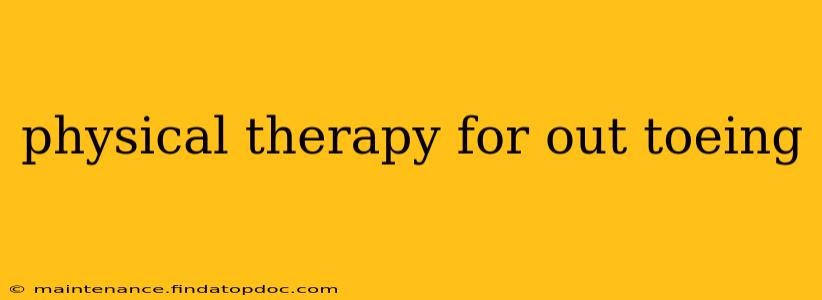Out-toeing, also known as external tibial torsion, is a condition where the feet point outward when walking. While often noticed in young children, it can persist into adulthood, causing discomfort and impacting gait. Fortunately, physical therapy can play a significant role in correcting out-toeing and improving overall lower limb function. This comprehensive guide explores various physical therapy techniques used to address this condition, answering common questions and providing insights into effective treatment strategies.
What Causes Out-Toeing?
Out-toeing can stem from several factors, including:
- Developmental issues: In infants and young children, it can be a normal developmental phase, often resolving on its own as they grow. However, underlying conditions like metatarsus adductus (in-toeing of the forefoot) or tibial torsion can contribute to persistent out-toeing.
- Genetic factors: Family history of out-toeing can increase the likelihood of developing the condition.
- Injury or trauma: Fractures or injuries to the leg bones during childhood can affect bone growth and lead to out-toeing.
- Neuromuscular conditions: Certain neurological or muscular conditions can influence foot positioning and gait pattern, resulting in out-toeing.
What are the symptoms of out-toeing?
The primary symptom of out-toeing is the noticeable outward turning of the feet while walking or standing. Other symptoms can include:
- Gait abnormalities: An altered walking pattern, often involving a waddling gait.
- Pain: In some cases, individuals may experience pain in the knees, hips, or lower back due to the compensatory movements needed to walk with out-toed feet.
- Increased risk of falls: The altered gait can increase the risk of falls, particularly in older adults.
- Foot fatigue: Excessive strain on the feet and ankles can lead to fatigue.
How can physical therapy help with out-toeing?
Physical therapy plays a crucial role in managing and correcting out-toeing, employing various techniques to address underlying causes and improve gait.
- Stretching exercises: Specific stretches target the muscles surrounding the hips, thighs, and ankles to improve flexibility and range of motion. These exercises can help to improve alignment and reduce muscle imbalances contributing to out-toeing.
- Strengthening exercises: Targeted exercises strengthen the muscles responsible for proper foot and leg alignment. This can improve stability and control over the feet and legs.
- Proprioceptive exercises: Exercises aimed at improving balance and coordination can help individuals regain control over their body’s position in space, reducing the tendency to out-toe. Examples include balance boards and wobble boards.
- Gait training: A physical therapist can guide individuals through gait retraining, focusing on proper foot placement and walking mechanics to promote a more efficient and natural gait pattern.
- Orthotics: In some cases, custom-made orthotics (shoe inserts) can help support the feet and provide corrective support, aligning the feet and reducing strain.
Does physical therapy correct out-toeing in adults?
While out-toeing is often more easily corrected in children, physical therapy can still be beneficial for adults. While complete correction might not always be possible in adults due to bone maturity, physical therapy can significantly improve gait, reduce pain, and enhance overall functional mobility. The focus is often on improving compensatory mechanisms and reducing strain on the joints.
What exercises can I do at home for out-toeing?
Several exercises can be performed at home to complement professional physical therapy. However, it’s crucial to consult a physical therapist to ensure you are performing these exercises correctly and safely. Examples include:
- Hip internal rotation stretches: These stretches help improve the inward rotation of the hip, counteracting the outward rotation associated with out-toeing.
- Ankle strengthening exercises: Exercises like toe raises and calf raises strengthen the muscles supporting the ankles and feet, improving stability.
- Heel-toe walks: This exercise helps improve coordination and gait pattern.
When should I see a physical therapist for out-toeing?
It's recommended to seek professional evaluation if out-toeing persists beyond childhood, causes pain or discomfort, significantly affects gait, or is accompanied by other symptoms. Early intervention can often yield better outcomes.
Can surgery correct out-toeing?
In severe cases where conservative treatments like physical therapy haven’t yielded sufficient improvement, surgery might be considered, particularly in children. However, surgery is usually a last resort.
Disclaimer: This information is intended for educational purposes only and should not be considered medical advice. Always consult with a qualified healthcare professional for diagnosis and treatment of any medical condition. The effectiveness of physical therapy varies depending on individual factors and the severity of the condition.
